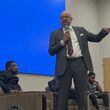Federal airport screeners will soon test new software on one full-body imaging machine at Hartsfield-Jackson International Airport, as part of an effort to allay privacy concerns raised about the devices.
The imaging machines have been used to screen some passengers going through airport security in Atlanta since 2008. The machines, also deployed at 77 other U.S. airports, generate images of passengers beneath their clothing as they scan for concealed weapons or explosives.
The new software will produce a “generic outline” with any anomalies highlighted on the outline, a move to offset criticism about revealing images.
In addition, both the passenger and screener will be able to view the screen with the generic outline, along with any anomolies shown. Currently, the images are viewed in a remote location. Any anomalies still would trigger additional screening. If there are none, the monitor will display “OK.”
The Transportation Security Administration hopes the new software also will boost the rate of processing through the imaging machines, but spokesman Jon Allen added that the most time-consuming process is the screening of carry-on bags, which will not change.
TSA started testing the imaging software in Las Vegas on Tuesday and plans to test it at Hartsfield-Jackson and Washington National in coming days. The software will be installed on one of the 14 imaging machines at Hartsfield-Jackson.
Testing will last 30 to 60 days, the TSA said.
“Testing this new software will help us confirm test results that indicate it can provide the same high level of security as current advanced imaging technology units while further enhancing the privacy protections already in place,” TSA administrator John Pistole said in a written statement.
Passengers can still opt out of the scan and choose a pat-down instead. The pat-down has also been criticized for being overly intrusive.






